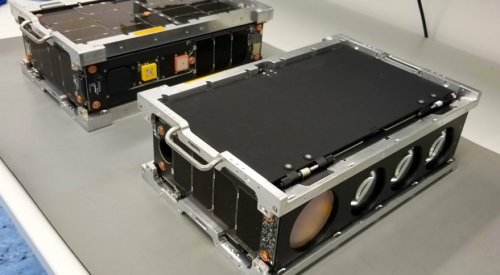At an oil and gas conference earlier this year, Scott Larson found a receptive audience for his startup’s future asset-tracking service.
“We lose stuff all the time,” an oil industry executive told Larson, chief executive for Helios Wire, a satellite-enabled Internet-of-Things startup based in Vancouver, Canada. If an employee parks equipment, like a $3 million fuel drum, in a farmer’s field but leaves the company before retrieving the drum and the company’s inventory management system fails to pick that up, the drum can be lost, the executive said.
Oil companies won’t pay $400 a year to insure that type of asset but they would pay Helios Wire “a couple dollars a month” to track it, Larson told SpaceNews.
Larson co-founded Helios in 2016 shortly after stepping down as CEO from UrtheCast, the now publicly traded company he started with brother Wade Larson in 2010 to capture live views of the Earth with an ultra-high-definition video camera mounted on the International Space Station.
Helios is preparing to launch its first satellite in October on a SpaceX Falcon 9 rocket. The firm’s previous attempt to send a satellite into orbit in November 2017 was unsuccessful because it was riding on a Russian Soyuz-2.1b rocket that failed. Helios plans to send another satellite into orbit on a Soyuz in December and a third on a February Soyuz flight.
Astro Digital, an Earth-imaging and analysis company, is building the 20-kilogram satellites with a machine-to-machine communications payload built to Helios Wire’s specifications.
With one satellite in orbit, Helios will begin booking revenue. With three, the venture will start to make a profit. From there, Helios will add more satellites to its constellation based on demand, Larson said.
Helios owns 30 MHz of priority mobile satellite system S-band spectrum it acquired from Sirion Global Ltd. of Australia.
“Spectrum is the asset,” Larson said. “If you don’t have that, you spend all your time trying to coordinate landing rights with various countries spread out all over the world, and those discussions aren’t for the faint of heart.”
With that spectrum, Helios plans to offer monitoring and tracking services to industries that can handle some delay in data reporting like infrastructure, transportation, shipping, energy and agriculture.
Helios customers will attach devices as small as cell phones to whatever they want to monitor or track, Larson said. The devices will “beep information to space, whatever information you want: location, elevation, temperature, proximity,” he added.
The Helios network will send that information through its satellites to existing ground stations and then uploaded it to a cloud, where customers can view it online or download it, Larson said. With one satellite, Helios will pick up the information once every 12 hours. With two, it would be every six hours and every four to five hours with three satellites, he said.
Larson estimates the space portion of the global Internet of Things market is worth “a couple billion dollars a year” shared by Inmarsat, Iridium Communications, Orbcomm and Globalstar. “We think we can capture 10 percent of the market with something that is just good enough,” Larson said.
Read more SpaceNews coverage from SmallSat 2018
- Why Sierra Nevada’s owners are betting big on Dream Chaser
- Iridium Next enters the homestretch
- LEO and MEO broadband constellations mega source of consternation
- SpaceX takes top honors in SpaceNews Awards for Excellence & Innovation
- Internet of Things startup Helios Wire raises $4 million for satellites
Share with your friends

(0) Comments
This article comments are currently no :(